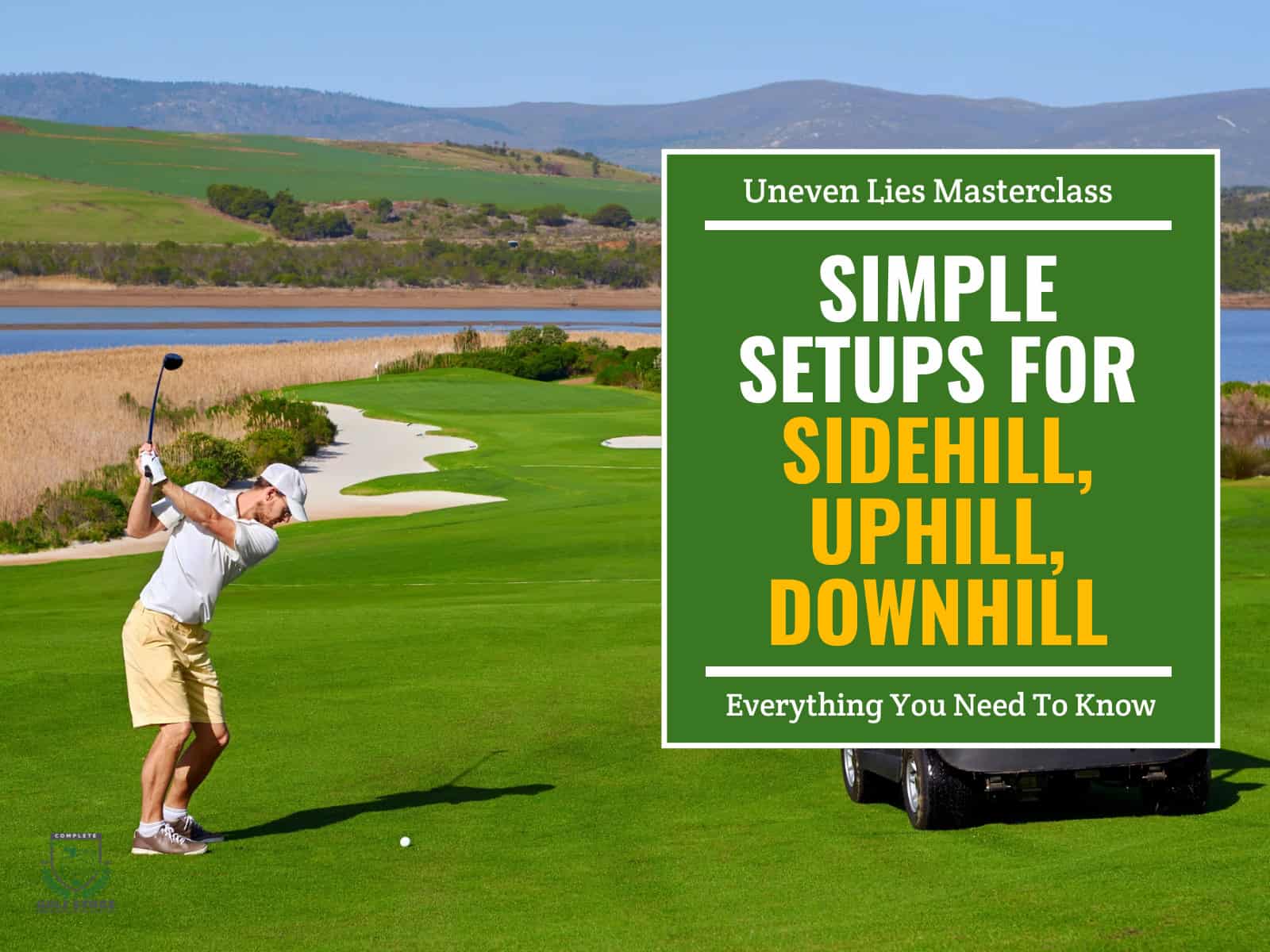Most of us golfers look like rock stars on the range, with smooth tempo, solid contact and balls flying straight. Then the round starts, and that silky swing seems to vanish. The difference isn’t your talent. It’s how you practice.
Hitting ball after ball on flat grass with no pressure trains comfort, not performance. On the course, every shot is a fresh puzzle, with a different lie, different wind and different stakes. The gap between those two worlds is why your range game doesn’t show up on the scorecard.
That’s where transfer practice steps in. It strips out lazy repetition and swaps in drills that mimic real golf. These drills add pressure, create consequences and force decisions, so practice sticks when it matters most.
This article breaks down nine of the simplest, smartest drills that make practice look and feel like the course. You’ll get the tools to carry your best swing from the range to the fairway.
- 1) The Goal: Transfer Practice to the Course
- 2) 1. Randomized Club Selection (Random Practice Golf)
- 3) 2. One-Ball Practice (Make Every Shot Count)
- 4) 3. Consequence Ladders (Accountability Under Stress)
- 5) 4. Pressure Sets: 10 Balls, 10 Clubs, 10 Targets/Lies
- 6) 5. Uneven-Lie Stations (Uphill, Downhill, Sidehill)
- 7) 6. Alignment Rod Accountability (Aim It Like You Play It)
- 8) 7. Takeaway Check with Sticks (Simple Path Constraint)
- 9) 8. Stability & Hip Pivot Rods (Body Control That Transfers)
- 10) 9. Spaced Reps: 20 Balls in 20 Minutes (No Raking, Real Focus)
- 11) Build a Weekly Transfer Routine (Simple, Repeatable)
-
12)
Frequently Asked Questions
- 12.1) How many days per week should I run transfer sessions without burning out?
- 12.2) What’s the fastest way to know if my practice is transferring besides score?
- 12.3) Can I do these drills into a net at home without full ball flight?
- 12.4) What if I’m a beginner; should I still grade shots 1–2–3?
- 12.5) Do I need alignment rods, or are there easy substitutes?
- 12.6) How do I combine technical swing work with transfer drills in one session?
- 12.7) What should I do when frustration spikes mid-drill without losing the constraint?
- 13) Final Thoughts
The Goal: Transfer Practice to the Course
Golf feels easy on the range—flat lie, no hazards, no pressure. On the course, everything changes. That’s why transfer practice matters.
A constraints-led approach sets rules or limits so you adapt. Instead of chasing perfect swings, you learn to handle real golf with different lies, pressure and decisions.
Blocked practice means hitting the same club to the same target. Random practice forces you to switch clubs, targets and lies every shot. It makes your brain work harder, and that’s what transfers.
Add consequence and spacing. Miss and start over. Pause between shots instead of raking balls. That space builds focus and calm under pressure.
1. Randomized Club Selection (Random Practice Golf)

Golf on the course never gives you the same shot twice. Yet on the range, most players hit twenty 7-irons in a row and call it practice. That’s not how you play the game.
Instead, rotate through clubs every swing. Go from driver to wedge to hybrid. Pick a new target each time. The order doesn’t matter; what matters is breaking the rhythm of repetition.
Here’s a simple sequence you can try:
- 5-iron to a long target.
- Sand wedge to a short flag.
- 3-wood down a fairway line.
- 8-iron to a mid-range pin.
Every shot forces a reset. New setup. New plan. New commitment.
This drill trains distance judgment and quick decision-making. It keeps your brain engaged, not asleep. You’ll notice misses get smaller, and confidence grows when faced with different lies on the course.
To make this drill even more effective, you can use DIY feedback systems for distance & dispersion to track shot outcomes without a launch monitor.
2. One-Ball Practice (Make Every Shot Count)

On the course, you only get one swing per shot. Yet on the range, it’s easy to rake another ball and erase the last mistake. That habit builds comfort but not confidence.
One-ball practice flips that script. Use a single ball and play it through a stretch of shots, just as if you were on the course. If you chunk it, you have to recover. If you pull it, you deal with the next swing from that result.
Here’s how to run it:
- Pick a starting point, maybe a wedge to a short target.
- After contact, move to the next station with the same ball.
- Mix in long clubs, short game shots and a putt if you can.
This drill creates natural consequence. Every swing matters. You’ll learn to lock in, trust your routine and handle recovery shots instead of avoiding them.
3. Consequence Ladders (Accountability Under Stress)
Golf changes when a shot has meaning. On the range, you can miss and swing again without penalty. On the course, a bad swing lingers. Consequence ladders close that gap.

The setup is simple. Pick a goal, like hitting three drives in a row through a fairway gate. Miss one, and you start over. The ladder builds pressure with every shot because the streak only matters if you finish it.
For short game, you might chip three balls inside a circle. Land one outside, and you reset. The same works for putting: make five in a row from four feet or go back to zero.
This format forces focus. You can’t fake a streak. Every swing carries weight, and that’s the point.
The beauty is in the balance; you decide the difficulty. Make the gate wider or the circle bigger if you’re learning. Shrink them as you improve.
4. Pressure Sets: 10 Balls, 10 Clubs, 10 Targets/Lies
Pressure sets recreate the nerves of the first tee. You only get ten swings, and every one matters. No mulligans, no extra tries.
The format is clear. Ten balls, ten different clubs, ten different targets or lies. After each swing, grade the shot:
- 1 = Good: hit your spot with the right flight.
- 2 = Playable: a small miss, but safe.
- 3 = Poor: a ball that costs strokes.
Scoring forces you to face the truth. You can’t hide behind “range rhythm” or endless retries. Each shot stands on its own, just like on the course.
This drill builds mental toughness. You’ll feel your heart rate rise, hands tighten and thoughts race. That’s the point: learn to swing under stress.
The beauty is in the finish. Ending practice with pressure sets cements the session, because the last thing your brain remembers is handling consequence.
5. Uneven-Lie Stations (Uphill, Downhill, Sidehill)

Flat lies are rare in real golf. Yet most range mats are perfectly level, teaching you comfort that doesn’t exist on the course. Uneven-lie stations change that.
Start simple. Create slopes with a practice mat on a board, or use natural ground if you have it. Hit from uphill, downhill and sidehill positions. Each lie forces a different adjustment.
For uphill shots, play the ball forward and swing with the slope. For downhill, move it back and stay balanced. Sidehill lies demand tweaks, as ball above your feet will pull left, below your feet will push right.
The goal isn’t perfection. It’s building instincts. You’ll feel how weight shift, balance and ball flight change with the ground beneath you.
6. Alignment Rod Accountability (Aim It Like You Play It)
Start with the basics. Lay one rod on the ground for your target line. Place another parallel to it for your feet. Aim the clubface first, then set your stance. You’ll see quickly if your body drifts open or closed.
For a tougher test, build a small alleyway a few yards ahead of the ball. Two rods, just wide enough for your shot to pass through. This forces you to square the face and trust your aim, not just your swing.
Here’s a tip: step in with your trail foot first. That angle sharpens your view of the target line, making it easier to set your stance.
The more you practice with rods, the more your eyes adjust. Soon you won’t just hope you’re aimed right: you’ll know.
7. Takeaway Check with Sticks (Simple Path Constraint)

A sloppy takeaway ruins the swing before it even starts. Most players either whip the club too far inside or snatch it outside. Both leave you fighting the ball the rest of the way.
One stick can fix it. Place a rod just outside the clubhead at address. Swing back slowly. If the shaft clips the stick, you’re off track. Adjust until the takeaway glides past clean.
Work partial swings first. Stop at waist-high and check your path. Once you feel it, blend into full swings. Don’t force the motion; let the club follow the constraint.
Different clubs need different angles. A driver sits flatter than a wedge, so tilt the stick accordingly. This keeps the drill real, not robotic.
8. Stability & Hip Pivot Rods (Body Control That Transfers)
Swings break down when the body shifts instead of turning. A simple rod can keep you honest.

Place one rod outside your trail hip at setup. If you sway into it during the backswing, you’ll feel the bump right away. The goal is to rotate around your spine, not slide off it.
For the lower body, set a rod near your trail ankle. On the downswing, your hip should move back and around, not shove toward the target. Too much space between you and the rod means the pivot stalled.
This feedback is instant. You don’t need video or slow motion, as your body knows when it hit the rod. Start with chips and pitches, then blend into full swings.
The real magic is how this drill carries over. When your pivot stays clean, balance improves, contact sharpens, and pressure swings feel steady.
9. Spaced Reps: 20 Balls in 20 Minutes (No Raking, Real Focus)
Mindless raking kills focus. When you hit ball after ball, your brain goes on autopilot. Spaced reps fix that by slowing you down and forcing you to reset.
Here’s the structure: 20 balls, 20 minutes. Each shot deserves its own routine. Take a rehearsal swing, step in, hit, then step back and reflect. That pause between swings is where the learning happens.
Add a two-step rule. Don’t hit until your practice swing matches the shot you want. Then pull the trigger. Afterward, ask yourself: Did it fly how I pictured it? Did I commit?
You can make it tougher by mixing swing speeds—20, 40, 60, 80 percent. Changing pace sharpens control and makes your swing adaptable under pressure.
Build a Weekly Transfer Routine (Simple, Repeatable)
Practice sticks when it follows a pattern. A weekly routine helps you hit all the right drills without wasting time or overthinking. Here’s how to make it simple and repeatable.

Session Structure That Sticks
Routine beats random buckets. To build real transfer, structure your session so every drill has a purpose.
- Warm up: start with alignment and takeaway checks to set your foundation.
- Main set: rotate through randomized clubs, consequence ladders and uneven lies. This mix keeps your brain active.
- Finisher: run a pressure set or a one-ball mini-round to test yourself under stress.
- Cooldown: close with spaced reps to sharpen focus and seal the work.
One loop through this structure gives you a practice day that feels like the course, not just the range.
Scoring, Breath and Intention
Numbers don’t lie. Give each shot a 1–2–3 score. A “1” is sharp, a “2” is playable, a “3” is costly. Track your patterns, not just your swings.
Before pulling the trigger, call your shot. State the target and shape. Then take a release breath, let tension fade, and commit.
Over time, these habits turn into automatic routines—the same ones you’ll lean on when the match is tight and your hands feel heavy.
Frequently Asked Questions
Everyone wrestles with doubt about practice. Our team provided answers to keep you focused on what matters most.
How many days per week should I run transfer sessions without burning out?
Two to three is plenty. More than that and you risk turning practice into a grind instead of sharpening your edge. Mix them in with technical work and light sessions.
What’s the fastest way to know if my practice is transferring besides score?
Track your misses. If your bad shots are playable instead of lost balls or chunks, you’re moving the needle. Score will follow.
Can I do these drills into a net at home without full ball flight?
Yes. You lose feedback on distance, but you keep the pressure, spacing and intent. Use clear targets and score your swings.
What if I’m a beginner; should I still grade shots 1–2–3?
Absolutely. The scale isn’t about perfection. It’s about awareness. A “2” swing that’s playable still counts when you’re starting out.
Do I need alignment rods, or are there easy substitutes?
Clubs work fine. So do driveway markers or even a stick from the ground. The key is having a reference, not fancy gear.
How do I combine technical swing work with transfer drills in one session?
Split it. Start with mechanics for 20–30 minutes. Then move to transfer practice so your brain learns to apply the move under pressure.
What should I do when frustration spikes mid-drill without losing the constraint?
Step back and breathe. Remind yourself the point is pressure, not comfort. Reset the drill and keep the rule in place. The discomfort is where the growth hides.
Final Thoughts
Golf punishes sloppy practice. If your range sessions don’t look like the course, your swing won’t hold when it matters. The cure is simple: add constraints, add consequence, add spacing.
Each drill forces you to focus on what counts: decision-making, commitment and adaptability. They strip away false comfort and replace it with real confidence.
Do them often enough, and your swing stops being a range-only trick. It becomes your game-day swing, the one that shows up under the gun.
To complement these practice strategies, it’s helpful to understand realistic golf distance benchmarks and how ball speed relates to breaking scoring milestones like 90 or 80.
Thanks for reading!





